
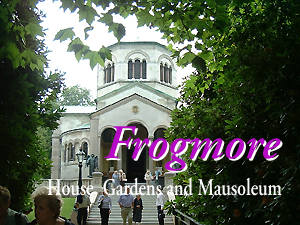 Opening
Times and Dates
Opening
Times and Dates
The Frogmore Mausoleum
Queen Victoria was the daughter of Edward,
the Duke of Kent and Princess Victoria of Saxe-Coburg.
She was born in Kensington Palace in London on May 24th, 1819.
At the age of 18, following the death of her uncle, William IV
in 1837, Victoria succeeded to the throne and was to rule for
64 years during one of the most significant periods of change
that the United Kingdom had ever witnessed.
Although the Industrial Revolution had started perhaps
75 years earlier with the coming of water-powered cotton mills
such as Cromford, Derbyshire (1771), the United Kingdom's most
successful economic period was doubtless in Victorian times.
The railways of Brunel and others spread nationwide, innovative
machines, products and processes of all kinds were developed,
plus of course the expansion of influence worldwide through the
creation of the British Empire. Whilst much of this development
would not be acceptable today, at that time there were many who
benefited from the generation of great wealth, sometimes to the
benefit of the working class, but of course, sometimes not. Throughout
this period, Queen Victoria reigned until her death in 1901 to
be succeeded by her son, Edward VII.
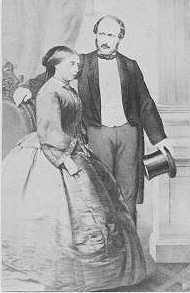
This picture was taken from an
exceedingly rare CDV from the late 1850's. It features an
art print of a photograph of Queen Victoria, and her husband,
Prince Albert.
Victoria's deep love for her husband Prince
Albert is well known and when he died on 14th December 1861,
of typhoid at Windsor Castle, Victoria was devastated. Within
four days she had ordered the Frogmore Mausoleum to be built
at her own expense in the gardens of Frogmore House. The Mausoleum
was to contain his human remains, and to be her future resting
place next to him.
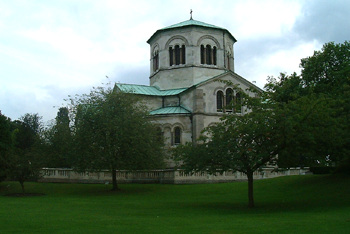 The Mausoleum from across the lawns
of Frogmore
The Mausoleum from across the lawns
of Frogmore
It is thought that Victoria's idea for
a mausoleum could have been inspired by a small Gothic building
built at Claremont by Prince Leopold of Saxe-Coburg
and designed by Papworth and Pugin. Originally intended as a
tea-house for Princess Charlotte, it became a shrine to her memory
after she died in childbirth in 1817. It survived until the mid-1920s.
In 1844 Prince Leopold's brother died, Duke Ernest
I of Saxe-Coburg-Gotha. The Duke's sons, Albert and Ernest, planned
a mausoleum at Coburg. This was designed by the architect Eberhardt
and Victoria is said to have thought it "beautiful and cheerful"
and it is likely that Victoria chose to erect a similar mausoleum
in Windsor for herself and her beloved Prince Albert.
An earlier mausoleum had already been built for Queen Victoria's
mother, the Duchess of Kent, on a rise, beside a lake, a short
distance from Frogmore House. The Royal
Mausoleum at Frogmore was designed by Ludwig Gruner of Dresden,
the designer of the earlier mausoleum. It is shaped as a Greek
cross and has an external diameter of 70 feet. (21 metres). Work
commenced in March 1862, just three months after Prince Albert's
death. Although the building could be consecrated in December
1862, it was a further nine years before the interior decorations
were completed in August 1871.
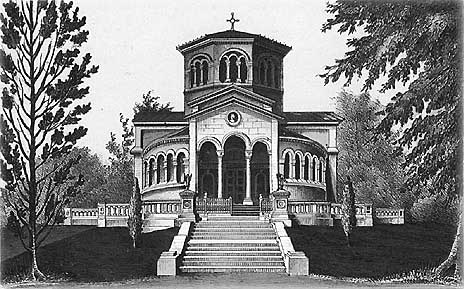 Frogmore Mausoleum from an illustration
published in the 1890s
Frogmore Mausoleum from an illustration
published in the 1890s
during Victoria's reign
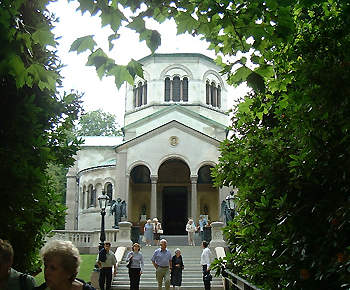 The entrance to Frogmore Mausoleum
in August 2002
The entrance to Frogmore Mausoleum
in August 2002
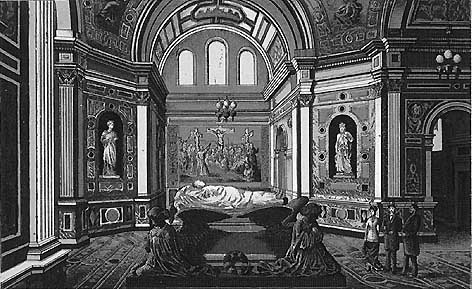 The interior of the Mausoleum illustrated
in the 1890s
The interior of the Mausoleum illustrated
in the 1890s
The Royal Mausoleum is a remarkable example
of Victorian building, sumptuously decorated inside with inlays
of coloured marbles from the UK, Italy, Greece, France, Portugal
(Emperor's Red), Africa and North America.
The walls are predominantly in the Portuguese red marble,
a gift from the King of Portugal, a cousin of both Victoria and
Albert, with the inlays in the other marbles from around the
world.
The external walls are of granite from Aberdeen and Mull
in Scotland, and Devon, Cornwall and Guernsey alongside Portland
stone. The roof is Australian copper.
At the entrance stand two bronze statues of angels bearing
a sword and a trumpet, by Georg Howaldt of Brunswick and dating
from 1878. In the centre above the archway is a terra cotta medallion
of the head of Christ, a gift of the Princess Royal, the Crown
Princess of Prussia.
After Victoria's death, the new king, Edward VII, put in
hand new stained glass windows, interior repainting of the dome,
and presented the large bronze lamps at the entrance.
The tomb itself was designed by Baron Carlo Marochetti.
The recumbent marble effigies of both the Queen and Prince Albert
were Marochetti's last works and although completed at the same
time, the effigy of the queen was not brought to Frogmore until
after her funeral. The sarcophagus was made from a single piece
of grey Aberdeen granite, said to be the largest block of flawless
wrought granite in existence and was the fourth to be quarried
for the purpose, the earlier three attempts being found to be
flawed on the underside after being cut from the quarry at Cairngall.
In the following ten years Queen Victoria's
popularity faded as she took almost no part in public life but,
with time, her royal engagements increased and during her Diamond
Jubilee in 1897 huge crowds gathered in the streets of London
to witness the great procession in her honour. The Queen is said
to have had tears in her eyes as the crowds roared their loyalty
as she passed by.
The beautiful Frogmore Gardens surrounding
Frogmore House and Mausoleum were designed in 1793 by Major William
Price.
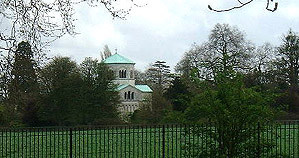
Frogmore Mausoleum, with its green
copper roof, is situated just to the
east of the Long Walk, not far from Windsor Castle.
Back to Top
Opening
Times and Dates
For
current information please see
The Royal Collection Website for Frogmore
Please email us
if this link no longer works
Thamesweb
Parking
Enter the Long Walk
from Park Street at the eastern end of Windsor High Street. Frogmore
is normally well sign-posted during open days. Look for the distinctive
yellow AA signs. Parking is available in the Long Walk adjacent
to the entrance to Frogmore. NB Cars are not normally permitted
in the Long Walk so enjoy this rare opportunity!
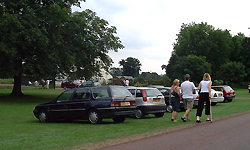
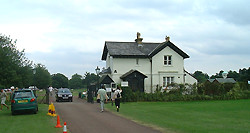 The entrance
from The Long Walk
The entrance
from The Long Walk
Travel by Train
Windsor Central Station (aka Windsor Royal Station) is
served by Paddington Station in London and the Great Western
railway from the West, Bristol and Reading direction. From the
north of England train services also run into London via Oxford,
Reading and Slough (change here for Windsor). This station is
closer to The Long Walk and Frogmore, but it is still a ten minute
walk. On leaving the station turn right towards the statue of
Queen Victoria and the Guildhall. Pass the Guildhall and continue
straight ahead into Park Street. At the end of Park Street enter
The Long
Walk - superb views
to the Copper
Horse and towards
the castle itself - proceed down the hill where you will come
across the entrance to Frogmore on the left, clearly signposted.
Trains also serve Windsor from
Waterloo Station in
London, arriving at the Windsor
and Eton Riverside Station.
When traveling from the south of England it may be preferable
to travel to Windsor via Clapham Junction and/or Staines.This
is a longer walk, up the hill around the castle, thereafter the
directions are as above from the Queen Victoria statue.
Please note, Frogmore may
not be suitable for children under 8 years of age.
A variety of charities
benefit from these open days so where groups or coach parties
are planning to visit, the organisers are invited to contact
the relevant charity for that day for further details and to
assist with planning.
Queen Victoria
- Significant Dates
Born: May 24th, 1819
Acceded to the
Throne: June 20th,
1837
Coronation: June 28th, 1838
Married Prince
Albert: February 10th,
1840
Death of Prince
Albert: December 14th,
1861
Death of Queen
Victoria: January 22nd,
1901
The funeral procession of Queen Victoria - Pictures
|
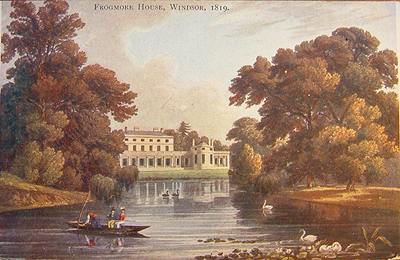 Frogmore House in 1819, the year
of Queen Victoria's birth,
Frogmore House in 1819, the year
of Queen Victoria's birth,
from a postcard of the very early 1900s
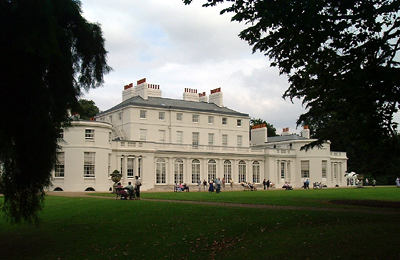 Frogmore House in August 2002
Frogmore House in August 2002
You may be interested in these webpages:
The Mausolea and Monuments Trust
The Mausolea and Monuments Trust is a charitable
trust, founded in 1997, for the protection and preservation for
the public of Mausolea and Sepulchral Monuments situated within
the United Kingdom of Great Britain and Northern Ireland.
|











